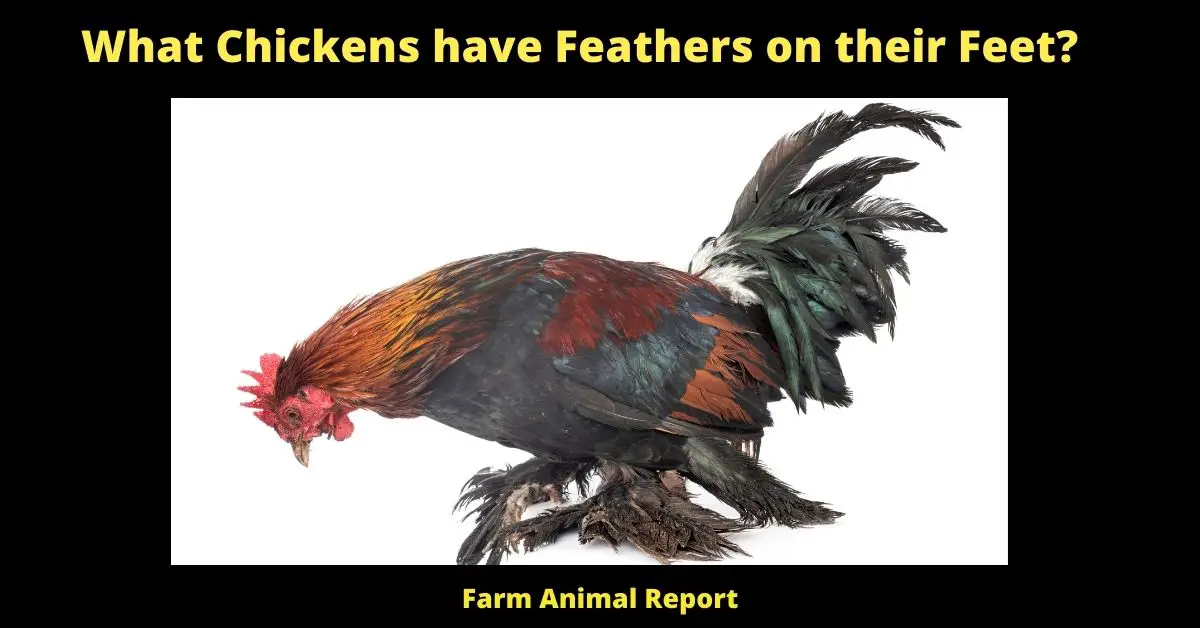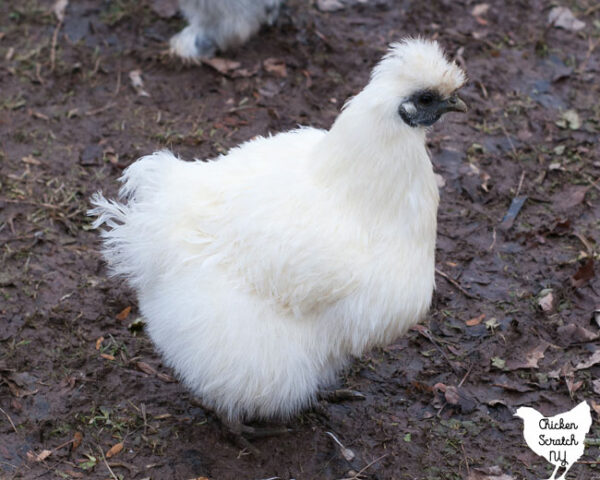Feather footed chickens are a great addition to your flock if you’re looking for something new. You can find chickens with fully feathered legs and breeds with giant bell bottoms.
Other than looks feathered feet don’t offer any extra benefits. However, it would be really cool if it let you walk on water like the basilisk lizard.
There are a few challenges unique to keeping birds with feathered feet. Most are environmental and easy to solve but one is medical in nature.
The biggest issue is with mud. I free range my birds and living in the North East we get lots of it. There are actually very few months where there isn’t at least a little mud.
The problem with mud and chickens with feathers on their feet shows up in the nest box. All those lovely feathers carry mud from the ground, into the nest box and onto the eggs.
I don’t wash fresh eggs unless absolutely necessary, the really gross ones go into a carton for my dog and the rest get wiped off before use.
Obviously, you don’t need feathered feet to track mud onto eggs but it’s definitely a much bigger issue with the feather-legged chickens.
Different types of chickens have different looks and sizes, but some breeds are known for having very fluffy feet. Chicken breeds with feathers on their feet stand out because of their fuzzy “boots,” and they add personality and charm to backyard flocks.
There are many breeds of chickens with fluffy feet, and this page will tell you about them and how to take care of them. Our guide will tell you everything you need to know about these chicks who are ready to show off their style.
An Overview of Feather-Footed Chicken Breeds
Many breeds of chicken have feathers all over their bodies, but only some breeds have long, fluffy feathers on their feet. This trait is caused by a dominant genetic mutation called ptilopody, which makes feathers grow where scales normally only grow.
Feathered leg breeds mostly came from China and Europe, where the extra insulation helped chickens stay warm in the winter. Their fluffy feet also helped protect them from animals that tried to grab them.
Today, chickens with feathers on their feet are kept more for ornamental purposes thanks to their unique, eye-catching appearance.
Some of the most popular feather-footed chicken breeds include:
- Cochins
- Brahmas
- Silkies
- Sultans
- Faverolles
- Booted Bantams
- Langshans
- Belgian d’Uccles
While individual breeds have their own distinct characteristics, most feathered leg chickens share qualities like calm, friendly personalities and hardiness in cold climates. Their fluffy feet also require a bit more maintenance to keep clean and free of debris.
The Benefits of Feather-Footed Chickens
Fluffy feet certainly look lovely, but they serve an important purpose beyond fashion. Here are some of the benefits feathered leg breeds offer:
Cold Protection
The key advantage of feathered feet is insulation against frigid temperatures. The plumage helps prevent frostbite on chickens’ toes and shanks during winter. Feathered leg breeds tend to thrive in colder climates where their foot fuzz acts like natural leg warmers.
Docile Personalities
In general, chickens boasting feathery feet tend to be calm and mellow, even compared to their unfeathered counterparts. Many are gentle enough for children to handle. They don’t tend to be overly skittish or aggressive, making them suitable for families and novice chicken owners.
Visually Striking
Let’s face it, feathered feet simply look spectacular. They give chickens a graceful, ornamental appearance perfect for showing or just adding visual interest to a backyard flock. The breeds sporting poufs of plumage on their feet certainly stand out in a crowd.
Potential Drawbacks of Feathered Feet
Of course, fabulously feathered feet don’t come without some challenges to consider:
Mess Magnets
Those fluffy feathers unfortunately love trapping dirt, mud, and moisture. Feathered leg chickens often end up with clumped, mucky feet. Keeping their foot feathers clean takes regular maintenance.
Increased Health Risks
Wet, dirty feathers can lead to problems like bacterial infections and foot issues. Pests like mites and lice can also easily hide in foot fluff. Checks and prevention are essential.
Possible Frostbite
Ironically, the feathering intended to protect legs from winter weather can also put chickens more at risk under certain conditions. Wet feathers in cold temperatures can actually accelerate frostbite.
Physical Hazards
Overly long, unkempt foot feathers can snag on surroundings or wrap around legs, posing injury risks. Trimming and monitoring are key to safety.
Caring for Feather-Footed Chickens
While fabulous, feathers on feet do require some specialized care. Here are tips for keeping your flock’s foot fuzz in fabulous form:
-
Provide a dust bathing station for fluff-footed chickens to naturally preen and clean their feathers.
-
Check feet weekly and trim any overly long or dirty feathers. Clean off mud and manure clumps gently.
-
Use absorbent bedding in the coop and elevate water dishes to minimize moisture. Wet conditions can cause health issues.
-
Boost feathered chickens’ immunity and deter pests with supplements like garlic, oregano, and diatomaceous earth.
-
Monitor for issues like bumblefoot, frostbitten toes, and infections, treating promptly under a vet’s guidance. Prevention is ideal.
With a little extra effort, your fancy-footed ladies (and gentlemen) can stay happy and healthy while dazzling your flock with their spectacular style!
Top Feather-Footed Chicken Breeds
If you’re ready to add a pair of fluffy footed chickens to your backyard flock, these breeds are fantastic options to consider:
1. Cochin
Covered in fluff from head to toe, Cochins are basically the chickens of people’s dreams. Their abundant, long feathering extends down their legs and over their toes. Despite their size, they have gentle dispositions perfect for families. While not the best egg layers, they make up for it with their friendly personalities.
2. Brahma
Also hailing from China, Brahma chickens have feathers covering their legs as well as pea combs thought to protect them from frostbite. Their large size – up to 12 pounds – gives them a commanding presence. Beneath their imposing stature, Brahmas are mellow giants that handle cold weather exceptionally well.
3. Silkie
Prized for their atypical appearance, Silkies are the lapdogs of the chicken world. Their entire body is covered in fluffy, downy plumage resembling fur. Though they have feathers on their legs and toes, their foot feathering is less abundant than other breeds. Beyond their fluff, Silkies are known for being calm, docile and liking human contact.
4. Sultan
Hailing from Turkey, Sultans distinguish themselves with their puffy head crests and abundant foot feathering. Their legs are a bit thinner than other feather-foot breeds, but still completely covered in fluff. Sultans are more delicate due to their small size and elaborate plumage. But they still make pleasing ornamental additions to flocks in need of fanciness.
5. Faverolles
This French breed stands out for their beards, muffs, and extra toe feathering. They also have feathers covering their shanks down to their toes. Faverolles have quirky personalities to match their eccentric style. They tend to be excellent, dependable layers while supplying plenty of flock entertainment.
6. Booted Bantam
A true bantam breed, Booted Bantams were created by crossing Belgian d’Uccles and Sultans to achieve their signature look. Long feathers adorn their thighs and shanks but don’t extend to their toes. Beyond their fashionable feet, Booted Bantams are spirited, active little chickens perfect for backyard flocks seeking beauty and liveliness.
So whether you’re looking to add ornamental flair or weather-hardy functionality, chickens boasting feathers on their feet have much to offer backyard flocks. Just be sure to provide any fluff-footed ladies the extra attention they need to keep their fabulous leggings in top form. Soon your chickens will be strutting their stuff in style!

Longer Distance to the Nest Boxes
It also helps if they need to take a longer walk from the door of the coop to the nest boxes, depending on the layout and size of your coop that may not be possible.
The further they have to walk through the bedding, the more time it has to soak up some of the mud and wetness.
Keeping Eggs Clean During the Mud Season

Assuming you can’t avoid the mud and you need to let your birds outside there are a few things you can do to keep the mess down.
Try to keep a thick layer of bedding on the floor of the coop. Wood shavings, straw, or dried leaves work well. It’ll help get the mud off their feet as they walk in to the coop.
what kind of chicken is this with feather in the feet
FAQ
What chickens have feathers on their feet?
Several chicken breeds have feathers on their feet, including Brahmas, Cochins, Silkies, Faverolles, and Langshans.
Why do my chickens have feathers on their feet?
Some chicken breeds naturally have feathers on their feet due to their genetics.
Do all Brahma chickens have feathers on their feet?
Yes, all Brahma chickens, regardless of color variety, are known for having feathered feet.
What breed is the black chicken with feathered feet?
Intro: The Booted Bantam, also known as the Dutch Booted Bantam, is a unique and charming breed of chicken known for its distinctive feathered feet. These delightful little birds are characterized by their unusual appearance, friendly nature, and historical significance.
